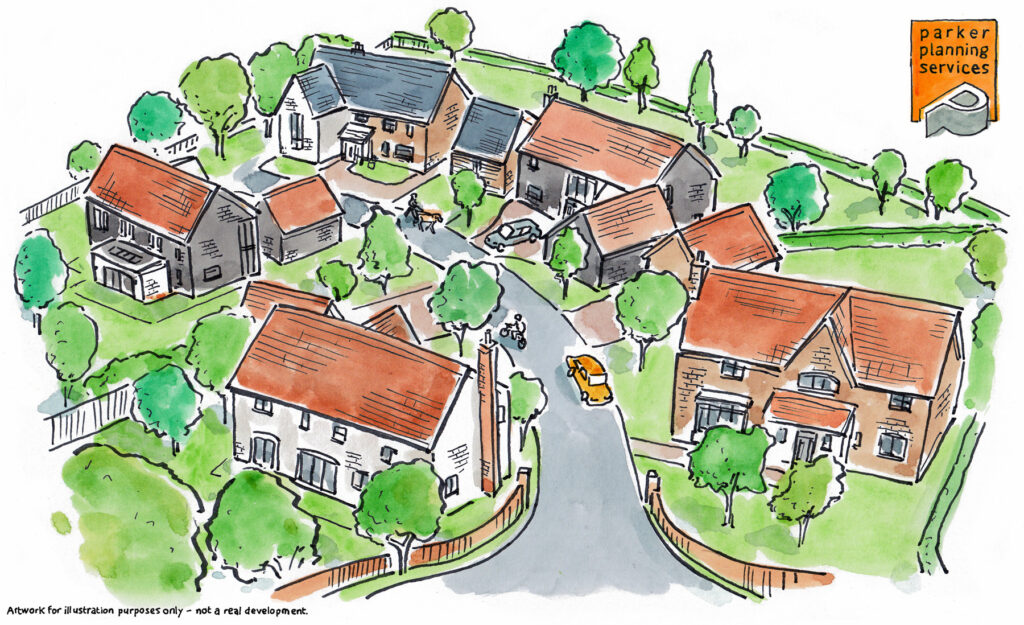This blog is written by a third-party guest author to help provide additional insight and perspective.
By Simon Henry, Principal Planning Manager, Parker Planning Services – an independent chartered town planning consultancy with specialist surveys and reports provision in-house, including heritage, archaeology and land surveying services. This guest post is part of a series of blog posts aimed at helping people better understand the benefits and processes involved in self build mortgages and building their own home.
Planning permission is an inescapable part of the process when it comes to building a new house. It refers to consent from your local authority for a proposed building and/or change of use. When deciding on whether to grant planning permission, local councils make decisions in line with national guidance in the form of the National Planning Policy Framework (NPPF) and local planning policies set out by the local authority.
Finding a self build plot is not an easy process. It can require patience and some luck along the way. Unless you are looking to build an architecturally interesting ‘Grand Design’ house where the design is of exceptional quality or looking to reuse and convert redundant buildings, plots in the open countryside are difficult to identify and develop. Therefore, the following opportunities may be worth considering:
- Gaps between and behind houses – it is usually easier to obtain planning approval for development when existing houses are nearby. For example, space beside houses that have easy access to the road can be a possibility.
- Replacement dwellings – these are sites that have an existing dwelling in place but they could be demolished and replaced through planning for a new, superior house. Often such projects are smaller dwellings that have a large garden.
- Disused land and brownfield sites – these are sites which had a previous use and are unlikely to be brought back into that use again. Examples can be old petrol stations, disused industrial buildings, an old telephone exchange, or even a scrap yard! But beware that some of these uses will require significant remediation in terms of contamination and cleaning sites up so that they are suitable for residential use.
Finally, any potential site should have suitable vehicle access to the public highway and sufficient land for on-site parking. This may be through a direct access or with a right of way over a shared access or neighbouring land.

When a suitable plot has been identified, gaining planning consent is the next stage. There are two main types of planning consent:
- Full Planning – which offers consent based on a detailed design being provided. The project must be shown to meet the planning conditions attached to the permission in order for the consent to be valid. These must be formally discharged in writing by the council before any building work commences.
- Outline Planning – which does not include specifics in the design and is to establish the ‘principle of development’ – in other words – if the site is suitable for a new building/house. An application for ‘reserved matters’, which may include details such as the size of the proposed house, appearance, position, landscaping, and access; will need to be submitted and approved before any building work can start on site.
Once planning has been granted, the permission will last for a specific period of time which will be outlined on the decision notice – usually three years from the date of decision, but this can vary. The process of finding out whether your application has been approved or refused should take eight weeks, but this can vary depending on the local authority and whether any further details have been requested as part of the application process.
Many self builders use the services of a planning consultant before they even buy a plot so that the potential of a proposed development can be worked out. This advice could save thousands of pounds on buying a site that is not suitable for development. The planning world is constantly changing, and consultants have full knowledge of the planning policies, designations, and technical work that is required in order to fully realise the potential of a site.
Guest post supplied by Parker Planning Services.
If you have land that you think might be suitable for a self build project, visit Parker Planning Sevices for a complimentary desktop appraisal of the site to assess your chances of planning permission.
By publishing and hosting information from guest authors on the Suffolk Building Society website, this does not constitute an affiliation with, nor a recommendation of, any third party organisation. We recommend that if the content of this article applies to you, or if you require further information on the particular topic it raises, that you seek specialist advice.


















